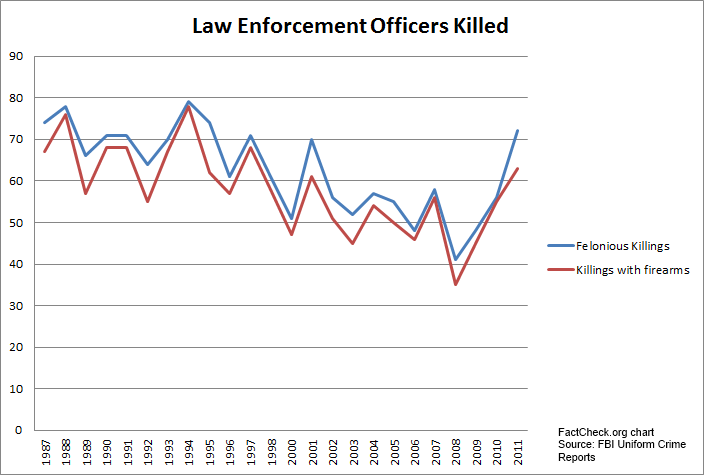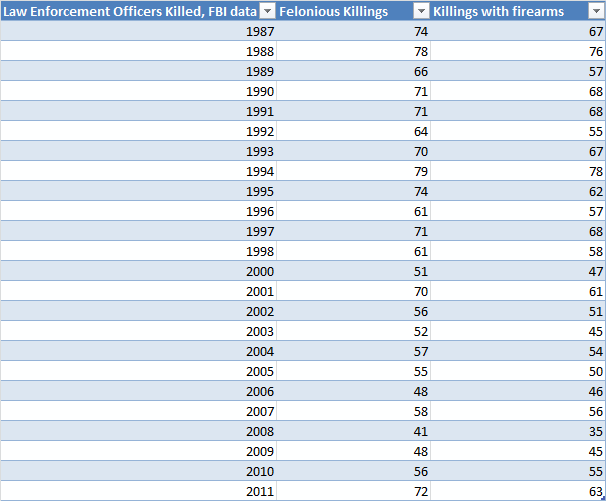In an online interview promoted by the White House, Vice President Joe Biden made the false claim that “there were fewer police being murdered … when the assault weapons ban, in fact, was in existence.” But the FBI statistics on killings of law enforcement officers show no such trend.
In fact, the number of officers killed when the ban was still in effect in 2002 — 56 — is the same number as in 2010. The numbers have fluctuated, but there’s no discernible pattern before, after or during the assault weapons ban.
California Sen. Dianne Feinstein made a related claim on CBS’ “Face the Nation” on Jan. 27, saying: “Do you realize that 1 out of every 5 law enforcement officers that’s killed is killed with an assault weapon?” That statistic comes from data collected from 1998 through 2001, when the assault weapons ban was in effect. Her comment may have left the wrong impression with some viewers that the 1-in-5 statistic applied to officer killings now and that a weapons ban might lower those numbers.
Biden’s Fireside Chat
We’ll start with Biden, who led a White House task force on gun violence. He made his claim in a Jan. 24 Google+ Hangout interview that the White House dubbed “Fireside Hangout.” It was held eight days after President Barack Obama laid out his plan to reduce gun violence. The “hangout” was hosted by PBS NewsHour’s Hari Sreenivasan and included questions and comments from four guests, including a technology expert, YouTube show host, grandmother, and a therapist. All participated remotely via webcam, with the vice president appearing, yes, in front of a fireplace, in the Secretary of War Suite in the Eisenhower Executive Office Building.
When asked about the effectiveness of the 1994-2004 assault weapons ban, Biden responded that it had made police officers safer. “There were fewer police being murdered, fewer police being outgunned when the assault weapons ban, in fact, was in existence,” Biden said. “And the number of assaults on police officers and the deadly assaults on them has gone up since the ban has been lifted.”
That’s simply not borne out by the facts.
We consulted the FBI Uniform Crime Reports data on law enforcement officers killed and assaulted. A chart of the number of killings of officers from 2002 to 2011 shows no apparent pattern. While there was a spike in murders in 2011 — 72 officers were killed — there’s no discernible trend in such murders, or murders by firearms, in the years during the ban and years since. The assault weapons ban was in effect from Sept. 13, 1994, to Sept. 13, 2004, when it expired.
During the 2002-2011 time frame shown on the FBI chart, the number of killings of law enforcement mainly fluctuated between the high 40s and high 50s year to year. The low point in that time period is 2008, several years after the weapons ban expired, when 41 officers were killed. Looking at only deaths by firearms — the method used for most of the killings — there’s also no discernible pattern post-ban.
We can go back further with FBI data. But, as the chart below shows, there’s no trend line of killings of officers going “up since the ban has been lifted” or down when the ban was in effect, as Biden said. Instead, the numbers have fluctuated greatly.
 Note that the FBI does not include officer deaths from the Sept. 11, 2001, terrorist attacks, which totaled 72. Its 2001 report explains: “Because a catastrophe such as the September 11 attacks falls far outside the normal course of police experience, the FBI has not included those fatalities in the 2001 rate, trend, or disposition tables for to do so would skew the data and render analyses meaningless.”
Note that the FBI does not include officer deaths from the Sept. 11, 2001, terrorist attacks, which totaled 72. Its 2001 report explains: “Because a catastrophe such as the September 11 attacks falls far outside the normal course of police experience, the FBI has not included those fatalities in the 2001 rate, trend, or disposition tables for to do so would skew the data and render analyses meaningless.”
Here’s another look at the data in raw numbers:
 In general, we could say that killings have decreased since the late 1980s and 1990s, when they repeatedly surpassed 70 per year. But that doesn’t demonstrate an effect from the assault weapons ban — particularly when killings remained lower after the ban expired in late 2004, with the exception of 2011. The average yearly killings from 1995 through 2004, roughly when the law was in effect, was 61. The average for subsequent years, 2005-2011, was lower, 54.
In general, we could say that killings have decreased since the late 1980s and 1990s, when they repeatedly surpassed 70 per year. But that doesn’t demonstrate an effect from the assault weapons ban — particularly when killings remained lower after the ban expired in late 2004, with the exception of 2011. The average yearly killings from 1995 through 2004, roughly when the law was in effect, was 61. The average for subsequent years, 2005-2011, was lower, 54.
There’s no discernible trend in assaults with firearms, either. In fact, the number of assaults with a gun on officers in 2010 — 1,925 — is nearly identical to the number in 2002 — 1,927.
Deaths With Assault Weapons
Feinstein, the Democratic senator who recently introduced new legislation to ban more than 100 firearms, argued in favor of an assault weapons ban on CBS’ “Face the Nation” on Jan. 27. She said: “Do you realize that one out of every five law enforcement officers that’s killed is killed with an assault weapon?”
She was accurately citing a report from the pro-gun control Violence Policy Center. But the report is old, and was based on officer killings when the assault weapons ban was in effect. Feinstein’s comment may well have left the impression with viewers that her statistic applied to officer killings now, and that a weapons ban might lower those numbers.
A 2003 report by the Violence Policy Center, titled “Officer Down,” showed that assault weapons were used in 20 percent of the 211 law enforcement officer killings between Jan. 1, 1998, and Dec. 31, 2001. That’s 1 in 5. Again, the assault weapons ban was in effect from September 1994 through September 2004.
The VPC study said that it “reveals the gun industry’s efforts to evade the 1994 ban and documents the significant threat assault weapons still pose to law enforcement.” It argued that the law needed to be stronger. “The fact that from 1998 through 2001 one in five law enforcement officers slain in the line of duty was killed with an assault weapon indicates that the ban in its current form is inadequate to protect police and the public from the hazards presented by assault weapons.”
We asked VPC if it had more recent data, or if it had updated its report since 2003. A press officer sent us information on weapons used to kill law enforcement officers in 2009, data VPC obtained after filing a Freedom of Information Act request with the FBI. Of the 48 officers killed, VPC notes that eight were killed with assault weapons. That’s 17 percent, or 1 in 6.
We don’t draw any conclusions from that. And, we note, as we have in the past, that sheer numbers don’t prove a cause-and-effect relationship one way or another.
In fact, two studies, which Feinstein cites on her website, found that they could not conclude that the assault weapons ban had had a meaningful effect. A 2004 study for the Department of Justice, conducted by Christopher Koper of the University of Pennsylvania, found that while the use of assault weapons in crimes had gone down, use of other semiautomatics that weren’t banned increased. “Therefore, we cannot clearly credit the ban with any of the nation’s recent drop in gun violence,” the report said.
— Lori Robertson